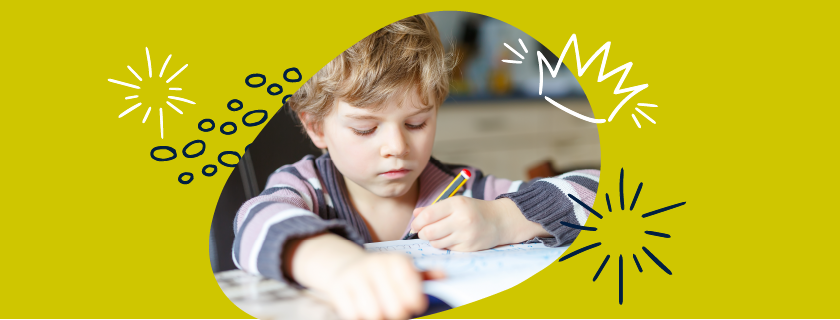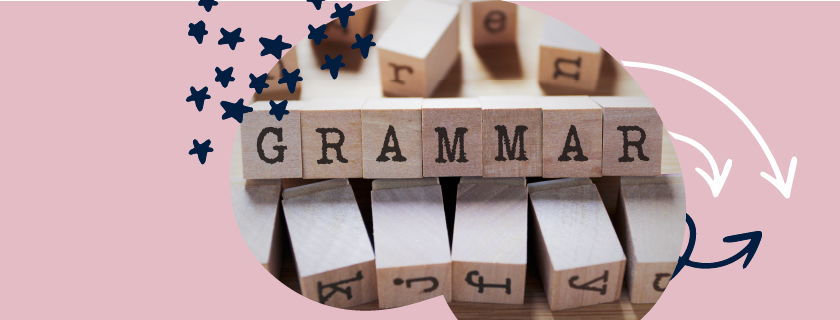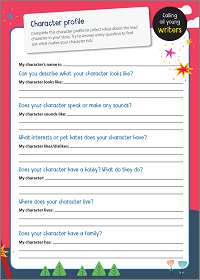Writing in Year 2 (age 6–7)
In Year 2, your child will learn to write sentences, discuss their writing, and read their writing aloud.
Read on to discover the National Curriculum expectations for writing in Year 2, and to find out how you can support your child at home.
How to help at home
There are lots of ways you can help your child with writing. Here are our top ideas.
1. Read to your child
While children do learn new language and ideas from speaking and listening, the type of language we use in writing is often very different from that in speech. Reading regularly to your child, especially longer chapter books that they might not be able to yet read independently, is a great way to support their writing.
While your child will have some favourite books and types of book that they’ll want to listen to again and again, try to make sure they get to hear a range of different types of books, including fiction and non-fiction. This is useful for their writing because it provides models for a wide of language styles.
For books to read with your child, take a look at our free eBook library.
2. Have your child to read to you
Making time to hear your child read isn’t just good for their reading. Seeing words in print helps them to understand the words, to spell them, and to see how grammar and punctuation are used to make meaning.
When you read, occasionally talk about why the author has decided to include something and how they written it. For example:
‘I wonder why the author has chosen to describe the castle as “gloomy”? I wonder what that tells us about what might happen there?’
3. Try some real-world writing
Writing for a real purpose can be a great way to fit in some practice. Writing cards, shopping lists, or letters/emails to relatives can be motivating real life reasons for writing, and can show children how useful it is to be able to write well.
Your child might enjoy keeping a diary or writing short stories based on books they have read or toys they enjoy playing with. Be sure to encourage your child to write about what most interests them, as this is the best way to keep them enthusiastiac.
4. Tell stories aloud
Giving your child the opportunity to tell stories orally is a great way to get them used to structuring their ideas and using adventurous language.
If they’re not sure where to start, see if they can retell a story that they already know well, like Little Red Riding Hood or Three Little Pigs.
If your child finds it useful to plan out their story first, try our free Story mountain to make a great plot or use our Character profile activity sheet to come up with an interesting lead character.
For more practical tips on helping your child improve their storytelling confidence, watch our storytelling skills video with Suzy Ditchburn.
Activity: Story Mountain
Complete the story mountain to plan your sotry with a beginning, middle, and end.
Activity: Character profile
Come up with lots of interesting details about the lead character in your story.
Video: How to develop storytelling skills
Suzy Ditchburn offers practical tips for improving storytelling confidence.
What your child will learn at school
In Year 2 (age 6–7), your child will learn to:
-
- Write simple, coherent narratives about personal experiences and those of others (real or fictional)
- Write about real events, recording these simply and clearly
- Demarcate most sentences in their writing with capital letters and full stops, and use question marks correctly when required
- Use present and past tense mostly correctly and consistently
- Use coordinating conjunctions (for example, and, or, and but) and some subordinating conjunctions (for example, when, if, that, and because) to join clauses
- Segment spoken words into phonemes and represent these by graphemes, spelling many of these words correctly and making phonically-plausible attempts at others
- Spell many common exception words
- Form capital letters and digits of the correct size, orientation and relationship to one another and to lower-case letters
- Use spacing between words that reflects the size of the letters.
Handwriting, spelling, grammar, and punctuation are all important aspects of writing too. You can find out more about them on our dedicated pages:

Handwriting in Year 2 (age 6-7)
Find out more about handwriting in Year 2 at Primary School.

Spelling in Year 2 (age 6-7)
Find out more about spelling in Year 2 at Primary School.

Grammar and punctuation in Year 2 (age 6-7)
Find out more about grammar and punctuation in Year 2 at Primary School.


